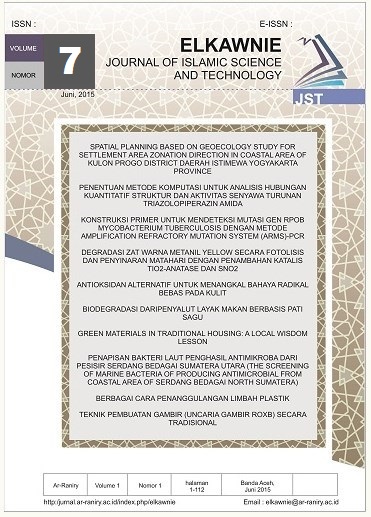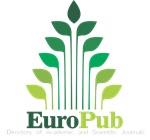The Alternative of Drainage Construction Technology Selection by Using Analytical Hierarchy Process Method
DOI:
https://doi.org/10.22373/ekw.v7i2.9880Keywords:
AHP, drainage, technologyAbstract
Abstract: The drainage channel is one of the complementary buildings on the road segment in requiring one of the technical requirements for road infrastructure. The road drainage channels in general are open channels using gravity to drain surface water or inundation to the channel. The distribution of flow in the drainage channel to this channel follows the contours of the highway so that the water will flow easily following gravity. The Several alternatives selection of drainage development technologies include elbow drainage, parallel, grid iron, natural and radial. The problem found that some factor considered in selection the right technology are the construction budget, construction period, material supply, and construction process affecting the selection process become complicated. The purpose of this study is to determine the dominant criteria required in considering the selection of drainage construction technology in Banda Aceh and to determine the proper alternative using Analytical Hierarchy Process (AHP) method. After distributing questionnaires to 16 respondents, the research found that the dominant criterion is the construction period as the score of 0.66. According to the respondents, the construction period become the most vital criteria since the assessment of criteria variable relate to the limitation in complete all drainage proposed. This study founds that the best alternative in selecting drainage construction technology is "parallel drainage" as the score is 4.96. Therefore, this study recommends the use of "parallel drainage" as a priority in the drainage construction Banda Aceh by considering construction budget, construction period, material supply and construction process.
Abstrak: Saluran drainase merupakan salah satu bangunan pelengkap pada ruas jalan dalam memenuhi salah satu persyaratan teknis prasarana jalan. Pada umumnya saluran drainase jalan merupakan saluran terbuka yang menggunakan gaya gravitasi untuk mengalirkan air limbah ke outlet. Distribusi aliran di saluran drainase ke outlet ini mengikuti kontur jalan raya sehingga air limbah akan lebih mudah mengalir secara gravitasi. Beberapa alternatif pemilihan teknologi pembangunan drainase antara lain adalah drainase elbow, parallel, gridiron, natural dan radial. Persoalannya, beberapa faktor yang perlu dipertimbangkan dalam memilih teknologi yang tepat, biaya pembangunan, waktu konstruksi, ketersediaan material, dan proses pembangunan sehingga pilihan menjadi rumit. Tujuan dari penelitian ini adalah untuk menentukan kriteria dominan yang perlu diperhatikan dalam pemilihan teknologi pembangunan drainase di Kota Banda Aceh dan menentukan alternatif yang tepat melalui metode Analytical Hierarchy Process (AHP). Setelah menyebarkan kuesioner kepada 16 responden, penelitian menemukan bahwa kriteria yang dominan adalah waktu pengerjaan dengan bobot tertinggi (0,66). Menurut responden, waktu konstruksi merupakan kriteria yang paling penting karena keterbatasan dalam menyelesaikan seluruh usulan pembangunan drainase perlu dipertimbangkan. Studi ini menemukan bahwa alternatif terbaik dalam memilih teknologi pembangunan drainase adalah “drainase paralel” yang memperoleh nilai kinerja tertinggi sebesar 4,96. Oleh karena itu, penelitian ini merekomendasikan penggunaan “drainase paralel” sebagai prioritas dalam pembangunan drainase di Kota Banda Aceh dengan pertimbangan biaya, waktu konstruksi, ketersediaan material, dan proses pembangunan.References
Al Hayyan, A. J., Wulan, S. M. M., Masduchi, R. H., Nugraheni, N., Poerwandari, D., Melaniani, S., Salimah, Mikami, Y., Tajima, F. (2021). Validity and reliability of the loco-check questionnaire after crosscultural adaptation for Indonesia. Journal of Orthopaedic Science. https://doi.org/10.1016/j.jos.2021.10.008
Alriansyah, M., Riogilang, R. H., Hendratta, L. A. (2019). Perencanaan system drainase berwawasan lingkungan dengan sumur resapan di lahan perumahan Wenwin-Sea Tumpengan Kabupaten Minahasa. Jurnal Sipil Statik, 7(2), 189-200.
Badzlina, M. F., Tazkiaturrizki, & Winarni (2019). Analisa perbandingan sistem drainase konvensional dan ecodrainage di Kawasan Perumahan Citra Maja Raya (Tahap I), Banten. Prosiding Seminar Nasional Pembangunan Wilayah dan Kota Berkelanjutan, Universitas Trisakti, 1(1), 213-221. http://dx.doi.org/10.25105/pwkb.v1i1.5279
Bai, X., & Qian, C. (2021). Factor validity and reliability performance analysis of human behavior in green architecture construction engineering. Ain Shams Engineering Journal, 12(4), 4291-4296. https://doi.org/10.1016/j.asej.2021.04.009
Ellafi, M. A., Deeks, L. K., Simmons, R. W. (2021). Application of artificial neural networks to the design of subsurface drainage systems in Libyan agricultural projects. Journal of Hydrology: Regional Studies, 35. https://doi.org/10.1016/j.ejrh.2021.100832
Fairizi, D. (2015). Analisis dan evaluasi saluran drainase pada kawasan Perumnas Talang Kelapa di Subdas Lambidaro Kota Palembang. Jurnal Teknik Sipil dan Lingkungan, 3(1), 755-765.
Gimenez-Maranges, M., Breuste, J., & Hof, A. (2020). Sustainable drainage systems for transitioning to sustainable urban flood management in the Europian Union: A review. Journal of Cleaner Production, 255. https://doi.org/10.1016/j.jclepro.2020.120191
Hasmar, H. (2012). Drainase Terapan. Ebook Teknik Sipil. Yogyakarta: UII Press. https://ebooktekniksipil.wordpress.com/air/drainase/drainasi-terapan/
Jia, L., Li, K., Shi, X., Zhao, L., Linghu, J. (2021). Application of gas wettability alteration to improve methane drainage performance: A case study. International Journal of Mining Science and Technology, 31(4), 621-629. https://doi.org/10.1016/j.ijmst.2021.04.002
Julita, R. (2016). Pemilihan teknologi pembangunan drainase dengan metode AHP. Prosiding Seminar Nasional Teknik Sipil 2016, Fakultas Teknik Universitas Muhammadiyah Surakarta, 227-234. http://hdl.handle.net/11617/7502.
Kinanti. (2018). Penerapan metode AHP untuk pembangunan saluran drainase trotoar. Jurnal Seminar Nasional Teknik Sipil, 3(2). https://jurnal.teknikunkris.ac.id/index.php/SEMNASTEK/article/view/46/42
Kitsikoudis, V., Erpicum, S., Rubinato, M., Shucksmith, J. D., Archambeau, P., Pirotton, M., Dewals, B. (2021). Exchange between drainage systems and surface flows during urban flooding: Quasi-steady and dynamic modelling in unsteady flow conditions. Journal of Hydrology, 602. https://doi.org/10.1016/j.jhydrol.2021.126628
Muliawati, D. N., & Mardyanto, M. A. (2015). Perencanaan penerapan sistem drainase berwawasan lingkungan (eko-drainase) menggunakan sumur resapan di Kawasan Rungkut. Jurnal Teknik ITS, 4(1), D-16 – D-20. https://dx.doi.org/10.12962/j23373539.v4i1.8833
Munthafa, A. E., & Mubarok, H. (2017). Penerapan metode Analytical Hierarchy Process dalam sistem pendukung keputusan penentuan mahasiswa berprestasi. Jurnal Siliwangi, 3(2), 192-201. http://jurnal.unsil.ac.id/index.php/jssainstek/article/view/355
Panchal, S., & Shrivastava, A. K. (2021). Landslide hazard assessment using analytic hierarchy process (AHP): A case study of National Highway 5 in India. Ain Shams Engineering Journal. https://doi.org/10.1016/j.asej.2021.10.021
Ransikarbum, K., Pitakaso, R., Kim, N., Ma, J. (2021). Multicriteria decision analysis framework for part orientation analysis in additive manufacturing. Journal of Computing Des Engineering, 8(4), 1141-1157. https://doi.org/10.1093/jcde/qwab037
Rurung, M. A., Riogilang, H., & Hendratta, L. A. (2019). Perencanaan sistem drainase berwawasan lingkungan dengan sumur resapan di lahan Perumahan Wenwin – Sea Tumpengan Kabupaten Minahasa. Jurnal Sipil Statik Universitas Sam Ratulangi, 7(2), 189-200. https://ejournal.unsrat.ac.id/index.php/jss/article/view/22025
Suprapto, M., Suyanto, & Prasetya, K. E. (2016). Prioritas perbaikan saluran drainase dengan metode Analytic Network Process (ANP) di Kelurahan Kadipiro bagian Barat. e-Jurnal Matriks Teknik Sipil UNS, 828-835. https://doi.org/10.20961/mateksi.v4i3.37090
Verma, N., & Patel, R. K. (2021). Delineation of groundwater potential zones in lower Rihand River Basin, India using geospatial techniques and AHP. The Egyptian Journal of Remote Sensing and Space Sciences. https://doi.org/10.1016/j.ejrs.2021.03.005
Yang, W., & Zhang, J. (2021). Assessing the performance of gray and green strategies for sustainable urban drainage system development: A multi-criteria decision-making analysis. Journal of Cleaner Production, 293. https://doi.org/10.1016/j.jclepro.2021.126191
Yin, H., Zheng, F., Duan, H. F., Zhang, Q., & Bi, W. (2020). Enhancing the effectiveness of urban drainage system design with an improved ACO-based method. Journal of Hydro-environment Research. https://doi.org/10.1016/j.jher.2020.11.002
Downloads
Published
Issue
Section
License
Proposed Policy for Journals That Offer Open Access Authors who publish with the Elkawnie journal agree to the following terms:
a. Authors retain copyright and grant the journal right of first publication with the work simultaneously licensed under a Creative Commons Attribution License that allows others to share the work with an acknowledgement of the work's authorship and initial publication in this journal.
b. Authors are able to enter into separate, additional contractual arrangements for the non-exclusive distribution of the journal's published version of the work (e.g., post it to an institutional repository or publish it in a book), with an acknowledgement of its initial publication in this journal.
c. Authors are permitted and encouraged to post their work online (e.g., in institutional repositories or on their website) prior to and during the submission process, as it can lead to productive exchanges, as well as earlier and greater citation of published work (see The Effect of Open Access).

























